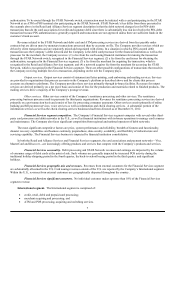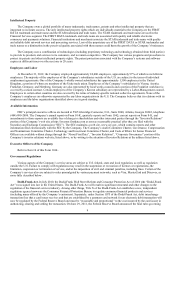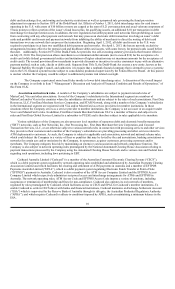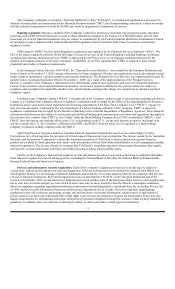First Data 2012 Annual Report Download - page 17
Download and view the complete annual report
Please find page 17 of the 2012 First Data annual report below. You can navigate through the pages in the report by either clicking on the pages listed below, or by using the keyword search tool below to find specific information within the annual report.
In addition, the Company relies on technologies supplied to it by third parties that may also contain undetected errors, viruses or
defects that could have a material adverse effect on the Company’ s business, financial condition and results of operations. Although the
Company attempts to limit its potential liability for warranty claims through disclaimers in the Company’ s software documentation and
limitation-of-liability provisions in the Company’ s license and customer agreements, the Company cannot assure that these measures
will be successful in limiting the Company’ s liability.
A
cquisitions and integrating such acquisitions create certain risks and may affect the Compan
y
’s operating results.
The Company has been an active business acquirer both in the United States and internationally, and may continue to be active in
the future. The acquisition and integration of businesses involves a number of risks. The core risks are in the areas of valuation
(negotiating a fair price for the business based on inherently limited diligence) and integration (managing the complex process of
integrating the acquired company’ s people, products, technology and other assets so as to realize the projected value of the acquired
company and the synergies projected to be realized in connection with the acquisition).
In addition, international acquisitions often involve additional or increased risks including, for example:
• managing geographically separated organizations, systems and facilities;
• integrating personnel with diverse business backgrounds and organizational cultures;
• complying with foreign regulatory requirements;
• fluctuations in currency exchange rates;
• enforcement of intellectual property rights in some foreign countries;
• difficulty entering new foreign markets due to, among other things, customer acceptance and business knowledge of these
new markets; and
• general economic and political conditions.
The process of integrating operations could cause an interruption of, or loss of momentum in, the activities of one or more of the
Company’ s combined businesses and the possible loss of key personnel. The diversion of management’ s attention and any delays or
difficulties encountered in connection with acquisitions and the integration of the two companies’ operations could have an adverse
effect on the Company’ s business, results of operations, financial condition or prospects.
The Company relies on various financial institutions to provide clearing services in connection with its settlement activities. If the
Company is unable to maintain clearing services with these financial institutions and is unable to find a replacement, the
Company’s business may be adversely affected.
The Company relies on various financial institutions to provide clearing services in connection with the settlement activities of
the Company. If such financial institutions should stop providing clearing services the Company must find other financial institutions to
provide those services. If the Company is unable to find a replacement financial institution the Company may no longer be able to
provide processing services to certain customers which could negatively impact the revenue and earnings of the Company.
Changes in laws, regulations and enforcement activities may adversely affect the products, services and markets in which the
Company operates.
The Company and its customers are subject to laws and regulations that affect the electronic payments industry in the many
countries in which the Company’ s services are used. In particular, the Company’ s customers are subject to numerous laws and
regulations applicable to banks, financial institutions and card issuers in the United States and abroad, and, consequently, the Company
is at times affected by these federal, state and local laws and regulations. The U.S. Congress and governmental agencies have increased
their scrutiny of a number of credit card practices, from which some of the Company’ s customers derive significant revenue. Regulation
of the payments industry, including regulations applicable to the Company and its customers, has increased significantly in recent years.
Failure to comply with laws and regulations may result in the suspension or revocation of licenses or registrations, the limitation,
suspension or termination of services, and/or the imposition of consent orders or civil and criminal penalties, including fines which
could have an adverse effect on the Company’ s results of operation and financial condition. The Company is subject to U.S. and
international financial services regulations, a myriad of consumer protection laws, economic sanctions, laws and regulations and anti-
corruption laws, escheat regulations and privacy and information security regulations to name only a few. Changes to legal rules and
regulations, or interpretation or enforcement thereof, could have a negative financial effect on the Company. In particular, the Dodd-
Frank Wall Street Reform and Consumer Protection Act (the “Dodd-Frank Act”), which was signed into law in July 2010, significantly
changes the U.S. financial regulatory system, including creating a new independent agency funded by the Federal Reserve Board to
regulate consumer financial products and services (including many offered by the Company’ s customers), restricting debit card fees
paid by merchants to issuer banks and allowing merchants to offer discounts for different
17
























